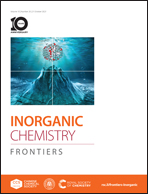Long-persistent far-UVC light emission in Pr3+-doped Sr2P2O7 phosphor for microbial sterilization†
Abstract
With the occurrence of global health events such as COVID-19, the development of high-performance ultraviolet-C (UVC) light sources for efficient and convenient sterilization applications holds promising scientific and engineering prospects. However, discovering reliable and stable luminescent materials capable of converting incident excitation energy to UVC radiation remains a challenge. Herein, we report a new Sr2P2O7:Pr3+ phosphor that exhibits exceptional capabilities in X-ray energy absorption, storage, UVC-light conversion, and persistent UVC light emission. Specifically, minutes of X-ray excitation can result in more than 24 h of continuous UVC persistent luminescence when monitored at 222 nm emission, realizing far-UVC afterglow for the first time. Intense UVC persistent light emission could be detected by a UVC corona camera in bright indoor and outdoor environments without interference from artificial light or natural sunlight, in consideration of the avoidance of the spectral overlap with ambient light. The self-sustained UVC persistent luminescence form was demonstrated as an optical-conversion strategy for sterilization application, whereby the charged Sr2P2O7:Pr3+ persistent phosphor could effectively inactivate infectious methicillin-resistant Staphylococcus aureus (MRSA) within 30 min in an excitation-free manner, offering new insights into developing UVC light sources for sterilization applications. This work expands the field of UV persistent luminescence research to the far-UVC spectral region and is expected to bring new and power-free solutions to some important applications where far-UVC light is needed, such as sterilization and photodynamic therapy.



 Please wait while we load your content...
Please wait while we load your content...